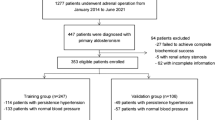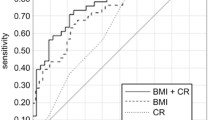Abstract
Purpose
Accurate subtyping of the primary aldosteronism into aldosterone-producing adenoma (APA) and idiopathic adrenal hyperplasia (IAH) is important to direct for specific treatment modalities. The objective of the study was to compare the clinical and biochemical parameters of APA and IAH patients to derive a Clinical Prediction Score reliably predicting APA from IAH.
Methods
This was a retrospective multi-centre study recruiting 38 APA patients and 42 IAH patients from four major hospitals in Hong Kong using database from Surgical Outcomes Monitoring and Improvement Programme and Clinical Data Analysis and Reporting System. Their clinical and biochemical parameters were evaluated.
Results
Patients in APA group were younger than IAH group (mean age 48.6 ± 9.2 vs. 57.1 ± 7.3 years old, p < 0.001), had more suppressed renin before saline infusion in saline infusion test (SIT) (median 0.19 [IQR 0.15–0.37] vs. 0.39 [IQR 0.19–0.69] ng/mL/h, p = 0.01), and higher aldosterone level after saline infusion in SIT (median 674 [IQR 498–1000] vs. 327 [IQR 242–483] pmol/L, p < 0.001). A clinical prediction score using three parameters was devised, comprising age at diagnosis < 50 years, PRA before saline infusion in SIT ≤ 0.26 ng/mL/h, and aldosterone level after saline infusion in SIT ≥ 424 pmol/L. A score of 2 would predict APA with a sensitivity of 84.2% and specificity of 88.1%, and a score of 3 would predict APA with a sensitivity of 31.6% and specificity of 100%.
Conclusions
Clinical Prediction Score based on the combination of age at diagnosis, PRA, and aldosterone level in the saline infusion tests could reliably predict APA from IAH.



Similar content being viewed by others
Data availability
The data that support the findings of this study are available but restrictions apply to the availability of these data due to data privacy and subjects’ confidentiality, and so are not publicly available. Data are, however, available from the corresponding author upon reasonable request and with permission of corresponding research ethnics committees.
References
Hannemann A, Wallaschofski H (2012) Prevalence of primary aldosteronism in patient’s cohorts and in population-based studies—a review of the current literature. Horm Metab Res 44(3):157–162
Piaditis G, Markou A, Papanastasiou L, Androulakis II, Kaltsas G (2015) Progress in aldosteronism: a review of the prevalence of primary aldosteronism in pre-hypertension and hypertension. Eur J Endocrinol 172(5):R191–R203
Rossi GP, Bernini G, Caliumi C, Desideri G, Fabris B, Ferri C et al (2006) A prospective study of the prevalence of primary aldosteronism in 1,125 hypertensive patients. J Am Coll Cardiol 48(11):2293–2300
Jansen PM, Boomsma F, van den Meiracker AH, Dutch AI (2008) Aldosterone-to-renin ratio as a screening test for primary aldosteronism—the Dutch ARRAT Study. Neth J Med 66(5):220–228
Young WF (2007) Primary aldosteronism: renaissance of a syndrome. Clin Endocrinol (Oxf) 66(5):607–618
Stowasser M, Sharman J, Leano R, Gordon RD, Ward G, Cowley D et al (2005) Evidence for abnormal left ventricular structure and function in normotensive individuals with familial hyperaldosteronism type I. J Clin Endocrinol Metab 90(9):5070–5076
Bernini G, Galetta F, Franzoni F, Bardini M, Taurino C, Bernardini M et al (2008) Arterial stiffness, intima-media thickness and carotid artery fibrosis in patients with primary aldosteronism. J Hypertens 26(12):2399–2405
Yang Y, Zhu LM, Xu JZ, Tang XF, Gao PJ (2017) Comparison of left ventricular structure and function in primary aldosteronism and essential hypertension by echocardiography. Hypertens Res 40:243–250
Reincke M, Fischer E, Gerum S, Merkle K, Schulz S, Pallauf A et al (2012) Observational study mortality in treated primary aldosteronism: the German Conn’s registry. Hypertension 60(3):618–624
Savard S, Amar L, Plouin PF, Steichen O (2013) Cardiovascular complications associated with primary aldosteronism: a controlled cross-sectional study. Hypertension 62(2):331–336
Milliez P, Girerd X, Plouin PF, Blacher J, Safar ME, Mourad JJ (2005) Evidence for an increased rate of cardiovascular events in patients with primary aldosteronism. J Am Coll Cardiol 45(8):1243–1248
Lin YH, Lin LY, Chen A, Wu XM, Lee JK, Su TC et al (2012) Adrenalectomy improves increased carotid intima-media thickness and arterial stiffness in patients with aldosterone producing adenoma. Atherosclerosis 221(1):154–159
Catena C, Colussi G, Lapenna R, Nadalini E, Chiuch A, Gianfagna P et al (2007) Long-term cardiac effects of adrenalectomy or mineralocorticoid antagonists in patients with primary aldosteronism. Hypertension 50(5):911–918
Remde H, Dietz A, Emeny R, Riester A, Peters A, de Las Heras Gala T et al (2016) The cardiovascular markers copeptin and high-sensitive C-reactive protein decrease following specific therapy for primary aldosteronism. J Hypertens 34(10):2066–2073
Rossi GP, Cesari M, Cuspidi C, Maiolino G, Cicala MV, Bisogni V et al (2013) Long-term control of arterial hypertension and regression of left ventricular hypertrophy with treatment of primary aldosteronism. Hypertension 62(1):62–69
Sechi LA, Novello M, Lapenna R, Baroselli S, Nadalini E, Colussi GL et al (2006) Long-term renal outcomes in patients with primary aldosteronism. JAMA 295(22):2638–2645
Funder JW, Carey RM, Mantero F, Murad MH, Reincke M, Shibata H et al (2016) The management of primary aldosteronism: case detection, diagnosis, and treatment: an endocrine society clinical practice guideline. J Clin Endocrinol Metab 101(5):1889–1916
Ganguly A, Dowdy AJ, Luetscher JA, Melada GA (1973) Anomalous postural response of plasma aldosterone concentration in patients with aldosterone-producing adrenal adenoma. J Clin Endocrinol Metab 36(2):401–404
Young WF Jr, Klee GG (1988) Primary aldosteronism. Diagnostic evaluation. Endocrinol Metab Clin N Am 17(2):367–395
Espiner EA, Ross DG, Yandle TG, Richards AM, Hunt PJ (2003) Predicting surgically remedial primary aldosteronism: role of adrenal scanning, posture testing, and adrenal vein sampling. J Clin Endocrinol Metab 88(8):3637–3644
Rossi GP, Barisa M, Allolio B, Auchus RJ, Amar L, Cohen D et al (2012) The Adrenal Vein Sampling International Study (AVIS) for identifying the major subtypes of primary aldosteronism. J Clin Endocrinol Metab 97(5):1606–1614
Nishikawa T, Omura M, Satoh F, Shibata H, Takahashi K, Tamura N et al (2011) Guidelines for the diagnosis and treatment of primary aldosteronism—the Japan Endocrine Society 2009. Endocr J 58(9):711–721
Stewart PM, Allolio B (2010) Adrenal vein sampling for primary aldosteronism: time for a reality check. Clin Endocrinol (Oxf) 72(2):146–148
Kupers EM, Amar L, Raynaud A, Plouin PF, Steichen O (2012) A clinical prediction score to diagnose unilateral primary aldosteronism. J Clin Endocrinol Metab 97(10):3530–3537
Zarnegar R, Bloom AI, Lee J, Kerlan RK Jr, Wilson MW, Laberge JM et al (2008) Is adrenal venous sampling necessary in all patients with hyperaldosteronism before adrenalectomy? J Vasc Interv Radiol 19(1):66–71
Phillips JL, Walther MM, Pezzullo JC, Rayford W, Choyke PL, Berman AA et al (2000) Predictive value of preoperative tests in discriminating bilateral adrenal hyperplasia from an aldosterone-producing adrenal adenoma. J Clin Endocrinol Metab 85(12):4526–4533
Sze WC, Soh LM, Lau JH, Reznek R, Sahdev A, Matson M et al (2014) Diagnosing unilateral primary aldosteronism—comparison of a clinical prediction score, computed tomography and adrenal venous sampling. Clin Endocrinol (Oxf) 81(1):25–30
Kocjan T, Janez A, Stankovic M, Vidmar G, Jensterle M (2016) A new clinical prediction criterion accurately determines a subset of patients with bilateral primary aldosteronism before adrenal venous sampling. Endocr Pract 22(5):587–594
Tiu SC, Choi CH, Shek CC, Ng YW, Chan FK, Ng CM et al (2005) The use of aldosterone-renin ratio as a diagnostic test for primary hyperaldosteronism and its test characteristics under different conditions of blood sampling. J Clin Endocrinol Metab 90(1):72–78
Nishizaka MK, Pratt-Ubunama M, Zaman MA, Cofield S, Calhoun DA (2005) Validity of plasma aldosterone-to-renin activity ratio in African American and white subjects with resistant hypertension. Am J Hypertens 18(6):805–812
Nanba K, Tamanaha T, Nakao K, Kawashima ST, Usui T, Tagami T et al (2012) Confirmatory testing in primary aldosteronism. J Clin Endocrinol Metab 97(5):1688–1694
Leung AA, Nerenberg K, Daskalopoulou SS, McBrien K, Zarnke KB, Dasgupta K et al (2016) Hypertension Canada’s 2016 Canadian Hypertension Education Program Guidelines for blood pressure measurement, diagnosis, assessment of risk, prevention, and treatment of hypertension. Can J Cardiol 32(5):569–588
Reznik Y, Amar L, Tabarin A (2016) SFE/SFHTA/AFCE consensus on primary aldosteronism, part 3: confirmatory testing. Ann Endocrinol (Paris) 77(3):202–207
Douillard C, Houillier P, Nussberger J, Girerd X (2016) SFE/SFHTA/AFCE Consensus on Primary Aldosteronism, part 2: first diagnostic steps. Ann Endocrinol (Paris) 77(3):192–201
Rossi GP, Auchus RJ, Brown M, Lenders JW, Naruse M, Plouin PF et al (2014) An expert consensus statement on use of adrenal vein sampling for the subtyping of primary aldosteronism. Hypertension 63(1):151–160
Monticone S, Satoh F, Giacchetti G, Viola A, Morimoto R, Kudo M et al (2012) Effect of adrenocorticotropic hormone stimulation during adrenal vein sampling in primary aldosteronism. Hypertension 59(4):840–846
Sang X, Jiang Y, Wang W, Yan L, Zhao J, Peng Y et al (2013) Prevalence of and risk factors for primary aldosteronism among patients with resistant hypertension in China. J Hypertens 31(7):1465–1471 (discussion 71–2)
Loh KC, Koay ES, Khaw MC, Emmanuel SC, Young WF Jr (2000) Prevalence of primary aldosteronism among Asian hypertensive patients in Singapore. J Clin Endocrinol Metab 85(8):2854–2859
Hashimura H, Shen J, Fuller PJ, Chee NYN, Doery JCG, Chong W et al (2018) Saline suppression test parameters may predict bilateral subtypes of primary aldosteronism. Clin Endocrinol (Oxf) 89(3):308–313
Venos ES, So B, Dias VC, Harvey A, Pasieka JL, Kline GA (2014) A clinical prediction score for diagnosing unilateral primary aldosteronism may not be generalizable. BMC Endocr Disord 14:94
Lau JH, Sze WC, Reznek RH, Matson M, Sahdev A, Carpenter R et al (2012) A prospective evaluation of postural stimulation testing, computed tomography and adrenal vein sampling in the differential diagnosis of primary aldosteronism. Clin Endocrinol (Oxf) 76(2):182–188
Feltynowski T, Ignatowska-Switalska H, Wocial B, Lewandowski J, Chodakowska J, Januszewicz W (1994) Postural stimulation test in patients with aldosterone producing adenomas. Clin Endocrinol (Oxf) 41(3):309–314
Umakoshi H, Xiaomei Y, Ichijo T, Kamemura K, Matsuda Y, Fujii Y et al (2017) Reassessment of the cosyntropin stimulation test in the confirmatory diagnosis and subtype classification of primary aldosteronism. Clin Endocrinol (Oxf) 86(2):170–176
Sonoyama T, Sone M, Miyashita K, Tamura N, Yamahara K, Park K et al (2011) Significance of adrenocorticotropin stimulation test in the diagnosis of an aldosterone-producing adenoma. J Clin Endocrinol Metab 96(9):2771–2778
Fontes RG, Kater CE, Biglieri EG, Irony I (1991) Reassessment of the predictive value of the postural stimulation test in primary aldosteronism. Am J Hypertens 4(9):786–791
Plamondon I, Agharazii M, Douville P, Lebel M (2007) Morning plasma aldosterone predicts the subtype of primary aldosteronism independent of sodium intake. Clin Exp Hypertens 29(2):127–134
Stowasser M, Ahmed AH, Cowley D, Wolley M, Guo Z, McWhinney BC et al (2018) Comparison of seated with recumbent saline suppression testing for the diagnosis of primary aldosteronism. J Clin Endocrinol Metab 103(11):4113–4124
Acknowledgements
We acknowledge the assistance from Surgical Outcomes Monitoring Improvement Programme Committee in recruitment of subjects.
Author information
Authors and Affiliations
Corresponding author
Ethics declarations
Conflict of interest
On behalf of all authors, the corresponding author states that there is no conflict of interest.
Ethical approval
This article does not contain any studies with animals performed by any of the authors. And the study had been approved by the respective Research Ethics Committee and Institutional Review Board of Hospital Authority in Hong Kong respectively (HKEC-2015-066, UW-16-069, KW/EX-16-081(98-24)).
Informed consent
The study was conducted on retrospectively collected patient records and there are no patient identifiers in the article. Therefore, informed consent was not required according to the respective research ethnics committee and institutional review board.
Additional information
Publisher's Note
Springer Nature remains neutral with regard to jurisdictional claims in published maps and institutional affiliations.
Rights and permissions
About this article
Cite this article
Leung, H.T., Woo, Y.C., Fong, C.H.Y. et al. A clinical prediction score using age at diagnosis and saline infusion test parameters can predict aldosterone-producing adenoma from idiopathic adrenal hyperplasia. J Endocrinol Invest 43, 347–355 (2020). https://doi.org/10.1007/s40618-019-01114-6
Received:
Accepted:
Published:
Issue Date:
DOI: https://doi.org/10.1007/s40618-019-01114-6




